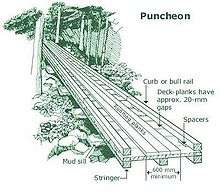Plank road
A plank road is a road composed of wooden planks or puncheon logs. Plank roads were commonly found in the Canadian province of Ontario as well as the Northeast and Midwest of the United States in the first half of the 19th century. They were often built by turnpike companies.

Origins
In the late 1840s plank roads led to an investment boom and subsequent bust. The first plank road in the US was built in North Syracuse, New York, to transport salt and other goods;[1] it appears to have copied earlier roads in Canada, which had copied Russian ones.[2] The plank road boom, like many other early technologies, promised to transform the way people lived and worked and led to permissive changes in legislation seeking to spur development, speculative investment by private individuals, etc. Ultimately, the technology failed to live up to its promise, and millions of dollars in investments evaporated almost overnight.[2]
Three plank roads, the Hackensack, the Paterson, and the Newark, were major arteries in northern New Jersey. The roads travelled over the New Jersey Meadowlands, connecting the cities for which they were named to the Hudson River waterfront.
U.S. Route 1 in Virginia follows the Boydton Plank Road from Petersburg southwards to just north of the North Carolina line.
On the U.S. West Coast the Canyon Road of Portland, Oregon was another important but short artery and was built between 1851 and 1856.

Kingston Road (Toronto) (Governor's Road) and Danforth Avenue, in Toronto, were plank roads built by the Don and Danforth Plank Road Company in the late 18th and the early 19th centuries. Highway 2 from Toronto eastwards was a plank road in the 19th century that was later paved.
Plank roads are used exclusively in the Canadian fishing outport of Harrington Harbour, Quebec because the town is built directly over a hilly, rocky shore. ATVs are the only mode of transportation there.
In Australia
In Perth, Western Australia, plank roads were important in the early growth of the agricultural and outer urban areas because of the distances imposed by swamps and the relatively-infertile soil. As it cost £2,000/km to construct roads by conventional means, the local councils, known as road boards, were experimenting with cheaper approaches to road building. A method called Jandakot Corduroy had been developed at Jandakot south-east of Perth: a jarrah tramway lay upon 2.3-metre-long (7.5 ft) sleepers, bounded by two 70-centimetre-wide (28 in) strips of jarrah planks for cart and carriage wheels. The 90-centimetre (35 in) gap was filled with limestone rubble to be used by horses. That reduced the cost of road building by up to 85% after its widespread introduction in 1908.[3] However, increased traffic and suburban development rendered the routes unsatisfactory over time, and by the 1950s, they had been replaced with bitumen surfaced roads.
See also
- Board track racing
- Boardwalk
- Corduroy road
- Duckboards
- Gallery road
- Historic roads and trails
- Marston Mat - a 20th-century equivalent for airport runways
- Old Plank Road Trail
- Sweet Track and Post Track
References
- University of California Transportation Center. "The Plank Road Boom of Antebellum, New York" (PDF). Archived from the original (PDF) on November 5, 2005. Retrieved 2006-04-25.
- Klein & Majewski. "Turnpikes and Toll Roads in 19th Century America". Retrieved 2014-04-18.
- Cooper, W.S.; G. McDonald (1999). Diversity's Challenge: A History of the City of Stirling. City of Stirling. p. 169.
External links
| Wikimedia Commons has media related to Plank roads. |
- The short film Military Roads (1943) is available for free download at the Internet Archive
- The Plank Road Craze - Background Reading
- Puncheon & corduroy roads
- Longfellow, Rickie. "Back in Time: Plank Roads". Highway History, Federal Highway Administration.